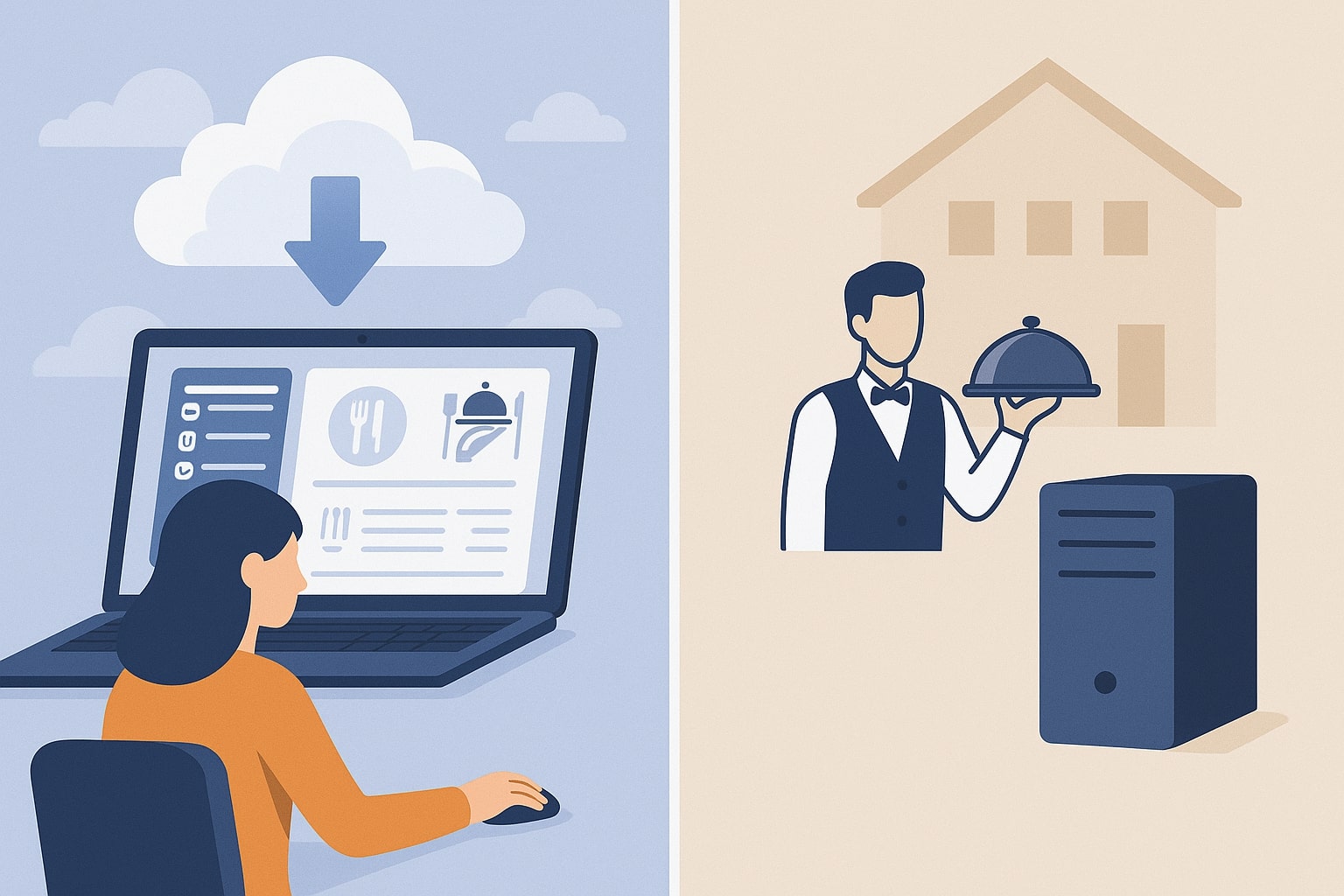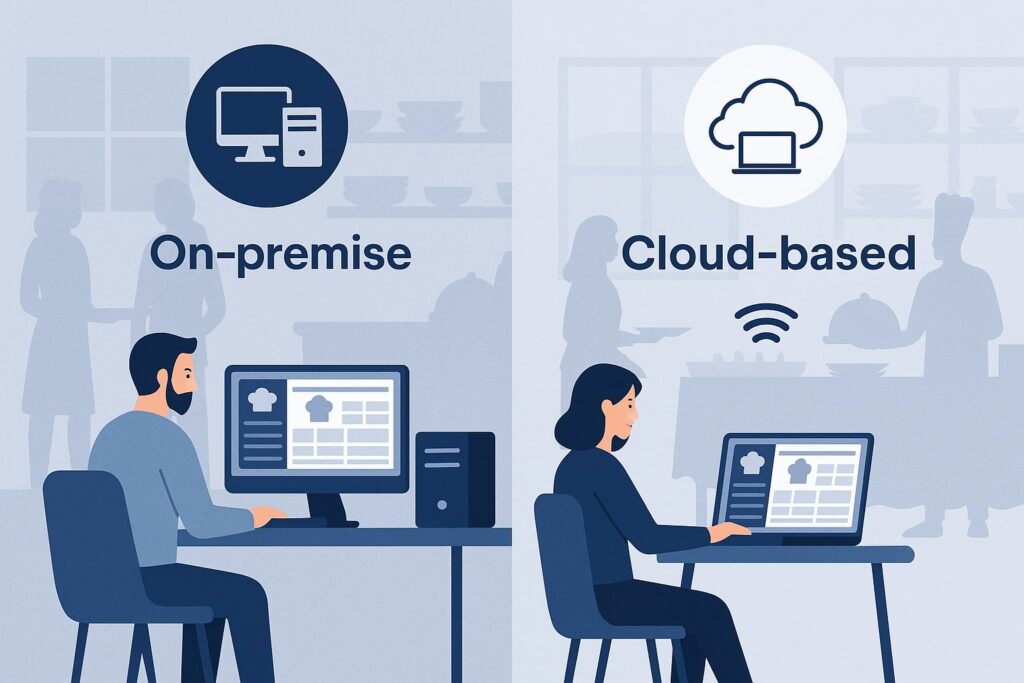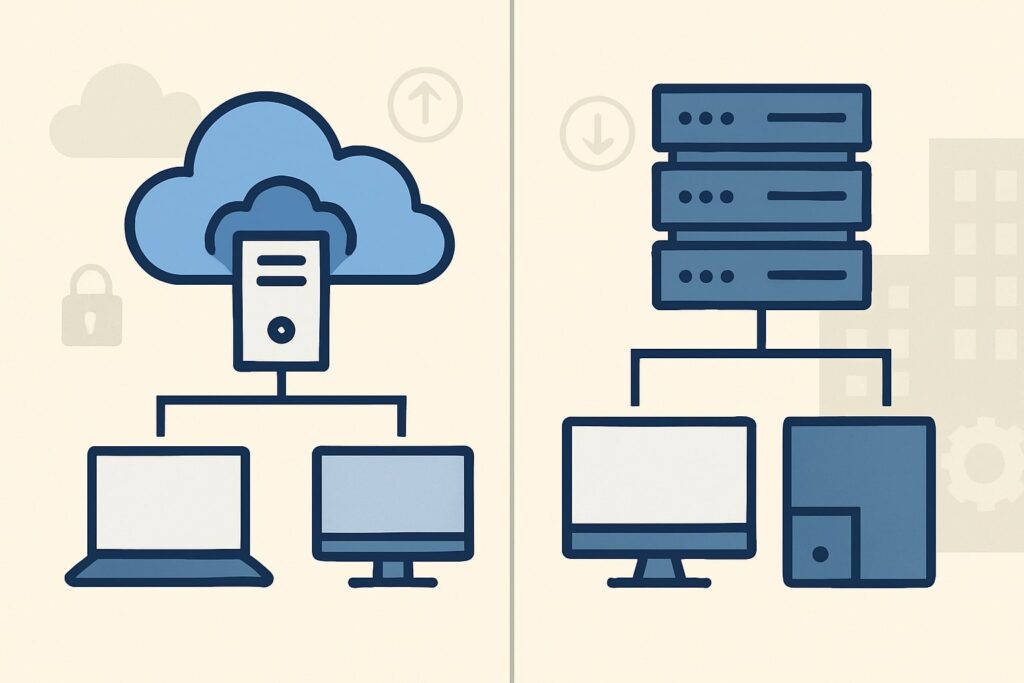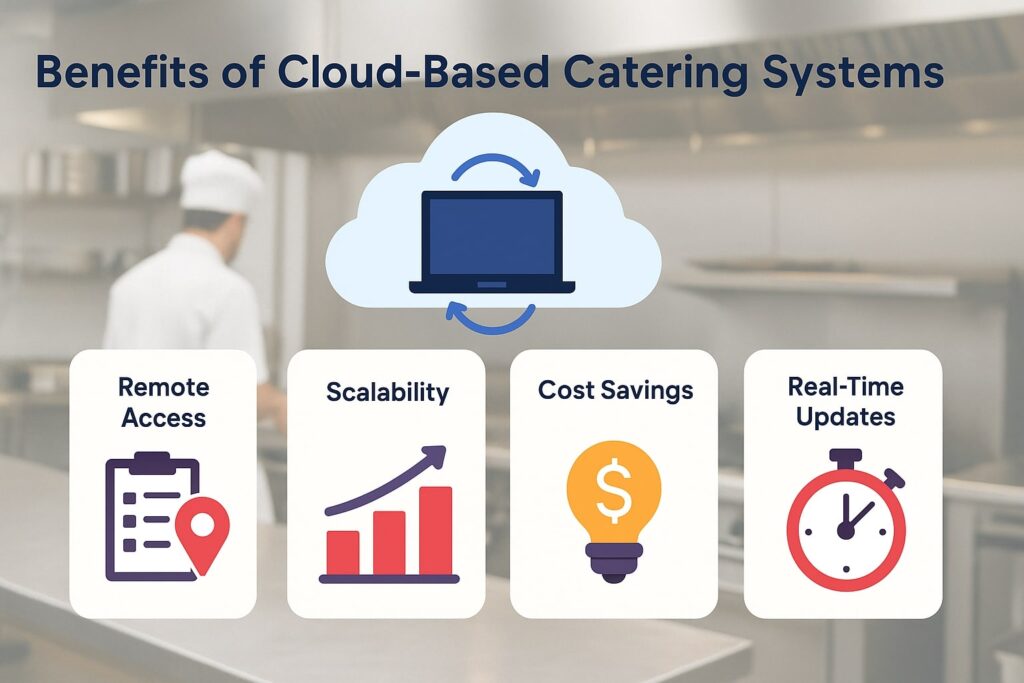
By cloudcateringmanager September 22, 2025
Catering management software has revolutionized how food service businesses operate. These systems help caterers streamline everything from event scheduling and menu planning to invoicing and inventory tracking.
A critical decision for any caterer today is whether to use a cloud-based (web-based) catering system or an on-premise (locally installed) catering solution.
In a cloud-based model, the software is hosted by a third-party provider and accessed online, whereas on-premise software is installed on the company’s own servers and maintained by its IT staff. Both approaches have distinct advantages and drawbacks.
This full comparison explores the definitions, benefits, and trade-offs of each deployment model to help catering business owners, IT professionals, and industry readers make an informed choice.
What Are Catering Management Systems?
Catering management (or catering software) refers to comprehensive platforms designed to run a catering business efficiently. These systems act like a “digital sous-chef,” organizing menus, client details, orders, and financials in one place.
They typically include event planning tools, client and vendor management, inventory and kitchen production features, and integrated billing. For example, catering software can automate proposal generation, coordinate delivery logistics, and track food costs in real time.
A recent industry analysis notes the global catering software market was about $3.5 billion in 2023 and is growing rapidly (projected to reach roughly $7.8 billion by 2032). This growth reflects the increasing need for digital tools to handle complex catering operations and customer demands.
As one guide reports, 79% of restaurant operators (many of whom do catering) say that technology gives them a competitive edge.
Deployment Models: On-Premise vs. Cloud-Based Catering Software

Before diving into features, it helps to clarify the two main deployment options:
- On-Premise Catering Software: This is traditional software installed on servers or computers owned by the catering company. The organization provides its own hardware and network, and its IT team is responsible for installing, updating, and securing the software.
On-premise catering systems give companies complete control over data and customization. However, they require significant upfront investment in hardware and IT resources, plus ongoing maintenance and manual updates. - Cloud-Based Catering Software: Also known as Software-as-a-Service (SaaS), this solution is hosted by a vendor in the cloud. The catering company accesses it over the internet (usually a web browser) and pays a subscription fee.
The vendor handles servers, updates, backups, and security. Users can log in from any device with internet access. Cloud-based systems trade higher ongoing subscriptions for lower upfront costs, automatic updates, and greater flexibility.
In other words, on-premise = software on your site, cloud = software on the vendor’s servers. Industry resources summarize the trade-off: “On-premise software offers greater control over customization, data management, and security measures, but comes with higher upfront costs and ongoing maintenance.”
By contrast, “cloud-based software enables easy scalability and reduced upfront costs but may raise data security concerns and offer less control”.
Key Differences Between Cloud and On-Premise Systems

Cloud and on-premise catering platforms differ in several important aspects. Understanding these differences will help you weigh which model fits your business needs. The following categories highlight the major contrasts:
Accessibility and Mobility
- Cloud: Cloud-based catering software can be accessed from anywhere with an internet connection. Most cloud systems offer mobile-friendly interfaces or apps, so staff can use tablets or smartphones in the field.
For example, CaterZen’s cloud platform allows managers to review orders and update schedules on the go. As one provider notes, “you can manage your catering business from anywhere with an internet connection, on any device (phone, tablet, or computer)”.
This mobility is a huge benefit for catering, where teams move between offices, kitchens, and event sites. Real-time updates mean that changes by one user instantly appear for others. - On-Premise: In contrast, on-premise systems are usually installed on a fixed network at your facility. You can only access them from the company’s computers or local network. If you leave the office or if your internet is down, you might not reach the system at all.
EventPro (an event/catering solution) emphasizes that on-premise software is “not nearly as dependent on your internet connection”, but this also means you lose the anytime-anywhere access to the cloud.
In practice, on-premise systems require being on-site or using complex VPNs, which can limit agility. - Summary: Cloud = high accessibility (mobile and remote access). On-Premise = limited to local network (less mobile, but not dependent on internet).
Cost and Pricing Models
- Cloud: Typically follows a subscription (Software-as-a-Service) pricing. You pay monthly or annually per user or per feature. This means lower upfront costs since you do not need to buy servers or infrastructure.
For example, cloud catering platforms often start around modest monthly fees. The flip side is that you keep paying as long as you use the software.
Many small businesses prefer this model because it is “pay-as-you-go” and preserves capital. As one review notes, “CaterZen operates on a subscription model, significantly lowering the initial investment”. - On-Premise: Requires buying the software licenses outright (often with a one-time fee) and investing in servers and network hardware.
This means high upfront costs. Over time, on-premise may have lower ongoing fees, but the initial investment can be a barrier for smaller caterers.
For example, On-Premise solutions often entail buying the server and maybe per-seat licenses. The higher front cost can be worthwhile for large enterprises that want to avoid perpetual subscription payments.
According to industry analysts, on-premise systems “may involve higher upfront investment for infrastructure”. - Summary: Cloud = lower initial cost (subscription model). On-Premise = higher upfront capital expenses (purchase of equipment/software).
Updates and Maintenance
- Cloud: Updates and maintenance are handled by the provider. The software is centrally hosted, so the vendor can roll out patches and new features automatically to all users. You never have to manually install upgrades.
CaterZen, for instance, ensures “you’ll always have access to the latest tools without lifting a finger”. This removes a big burden from the caterer’s IT team.
For many businesses, this “set it and forget it” model is attractive. It means faster access to new features and security fixes without downtime for upgrades. - On-Premise: You are responsible for installing updates and patches on your own hardware. That requires an IT team to download new versions, test compatibility, and apply them (often after-hours to avoid disrupting operations).
Updates can be time-consuming and expensive. According to a TechAdvice guide, on-premise software comes with “ongoing maintenance, updates, and infrastructure” costs. If your catering business lacks IT staff, you may need to hire outside consultants. - Summary: Cloud = provider-managed updates (automatic, minimal IT effort). On-Premise = manual updates and maintenance (requires IT resources).
Scalability and Flexibility
- Cloud: One of the biggest advantages is ease of scaling. If your business grows or you have seasonal spikes, you can quickly add more users, events, or features in the cloud.
There’s usually no need to buy extra hardware; the cloud provider manages the expansion. CaterZen emphasizes that its platform “can scale as your business grows”, letting you “only pay for what you need”.
In practical terms, a cloud system can handle sudden increases (e.g., a big holiday) without advanced notice. The National Restaurant Association notes that as catering demand rises, cloud systems are preferred for their “scalability without hefty upfront costs”. - On-Premise: Scaling is more difficult. To support more users or data, you may need to purchase additional servers, increase storage, or invest in stronger network infrastructure.
Each expansion is a significant IT project. If your catering business suddenly doubles in size, you can’t instantly add capacity on-premise without buying hardware. This inflexibility is a drawback for fast-growing companies.
TechAdvice notes cloud “offers easy scalability”, while on-premise often needs “additional investments in hardware”. - Summary: Cloud = easily scalable (add resources on demand). On-Premise = scaling requires new hardware purchases and is less agile.
Data Security and Control
- Cloud: Security in the cloud is managed by the provider. Reputable catering software vendors invest heavily in encryption, secure data centers, and automatic backups.
For example, CaterZen uses industry-standard encryption and RAID storage for failover. This means your data is stored off-site in secure facilities (often with redundancy), and the cloud vendor handles disaster recovery.
However, some businesses feel uneasy about sensitive data being stored off-premise. They worry about data privacy or compliance (e.g., certain event data). - On-Premise: You have full control over your data’s security environment. The data is stored on your servers, behind your firewalls. This can be an advantage if your business has specific security policies or regulatory needs.
You can customize security measures (encryption, access rules, backups) to your standards. As an EventPro guide notes, one benefit of a desktop/on-prem solution is “you control the security measures on your own computer, rather than relying on a third-party cloud server”.
If the internet or cloud provider fails, your data is still local and accessible (assuming your local network and power are up). - Summary: Cloud = security handled by vendor (reliable but less direct control). On-Premise = full internal control of data and security policies.
Customization and Integration
- Cloud: Most cloud catering platforms allow some customization (menus, forms, branding, etc.), but they are generally built on a standardized platform. You choose from features the vendor provides.
Deep custom changes are often limited by the software design. However, cloud solutions typically offer robust integrations with third-party tools (e.g., accounting, CRM, email).
For instance, CaterZen integrates with QuickBooks, payment gateways, Google Calendar/Docs, and more. These built-in connections can streamline workflows (e.g., syncing invoices to your accounting app). - On-Premise: Because you own the system, on-premise solutions can often be customized more extensively. You may have access to the source code or APIs to tailor modules exactly to your needs.
This can be important for large operations with unique processes. On-premises also integrates readily with other local systems (restaurant POS, network drives, etc.) since everything is on the same network.
Some businesses choose on-premise to ensure seamless links to in-house databases or proprietary software. - Summary: Cloud = standard feature set with many easy integrations. On-Premise = deeper customization and tight in-house integration possible.
Internet Dependency and Reliability
- Cloud: By definition, cloud software requires a stable internet connection to function. If your internet is slow or goes down, users cannot access the system (unless some offline mode is provided).
This is a risk for remote event sites with poor connectivity. Most cloud vendors maintain high uptime (e.g., 99.9% SLAs), but local outages (ISP issues) could interrupt service. - On-Premise: One clear advantage is resilience to internet failure. Even if the office internet is down or an event site is off-grid, the on-premise system can continue operating because it’s on the local network.
EventPro points out that with on-premise applications, you can carry on using most core features even through internet outages. So for caterers who frequently work in areas with unreliable connectivity, on-premise can be more dependable day-to-day. - Summary: Cloud = requires internet (with vendor backup, but reliant on connection). On-Premise = works offline on local LAN (handles internet outages better).
Benefits of Cloud-Based Catering Systems

Cloud-based catering systems offer numerous advantages for today’s mobile, growth-oriented caterers:
- Anywhere Access & Mobility: Teams can log in from the office, warehouse, vehicle, or event site using laptops, tablets, or phones. This means sales staff can take orders in the field, and chefs can update menus on the fly. Real-time data ensures everyone sees the latest information, improving coordination.
- Lower Upfront Costs: No need to buy expensive servers or network hardware. You can start with a small subscription plan and scale up as needed.
This is ideal for startups and small caterers that want professional software without a big investment. The “pay-as-you-grow” model makes budgeting easier. - Automatic Updates & Low IT Overhead: The software vendor handles updates, patches, and maintenance. Your staff always has the latest version with new features, without downtime for upgrades. This frees your team from tedious tech tasks and reduces IT staffing costs.
- Scalability & Flexibility: Quickly add more users, event slots, or modules when business expands. Cloud platforms can smoothly handle a surge in events without new hardware. You only pay for extra capacity when you need it.
- Robust Security & Backups: Leading cloud vendors use professional data centers with strong security (firewalls, encryption, redundancies).
They typically include automated daily backups and disaster recovery. For many small caterers, this level of security is higher than they could afford on their own. - Easy Collaboration: Multiple team members can work on the same accounts or events simultaneously from different locations.
If a sales rep updates an order, a scheduler in another city sees it instantly. This real-time collaboration streamlines coordination across departments and locations. - Rich Integrations: Most cloud platforms easily connect to popular services. For example, you can link your catering app to Google Calendar for scheduling, QuickBooks for accounting, or online ordering portals. These integrations reduce manual data entry and create seamless workflows.
- Modern Features: Cloud solutions often pioneer new features. Many now offer mobile apps, online client portals, analytics dashboards, and even AI-driven insights (e.g., predicting inventory needs). Keeping up with technology is easier because the vendor updates the software continuously.
In summary, cloud catering systems are ideal for growing caterers who need mobility, minimal IT overhead, and fast scaling. They align well with current industry trends toward remote work and digital ordering.
Benefits of On-Premise Catering Systems
On-premise catering solutions also have strong points, especially for businesses with specific needs:
- Control and Security: You keep all data on your own servers behind your firewalls. For organizations with strict data policies or compliance requirements, this direct control can be reassuring. You can tailor your security measures (encryption, backups, access rules) and know exactly where the data resides.
- Reliability Offline: Since the software runs on local machines, it continues working without internet. Your team can serve clients and process orders during network outages or at venues with poor connectivity. This continuity can be critical for events in remote areas.
- Customization: On-premise software often allows deeper customization to match your unique workflows. If your catering operation has special processes or legacy systems, an on-premise solution can be molded (with developer help) to fit precisely.
- Predictable Ongoing Costs: Once the system is purchased, there may be no mandatory monthly fees (aside from maintenance contracts). Over many years, the total cost can be lower for a large, stable organization if server refreshes are infrequent.
- Performance: On-premise software can be faster in local use because data doesn’t travel over the internet. Complex tasks (like generating large reports or managing huge menus) run on your own high-performance hardware.
- Independence: You aren’t reliant on a vendor’s business health or pricing changes. You own the software license and can upgrade on your schedule.
These benefits make on-premise catering systems appealing for established, data-sensitive caterers with robust IT teams.
For example, large event caterers or venues with in-house tech staff might prefer the control and reliability of an on-site solution. However, remember that you must also handle backups, maintenance, and hardware upgrades yourself.
Industry Trends and Adoption
The catering industry is rapidly embracing digital tools. As noted, the catering software market is growing over 9% per year. This reflects two trends: moving away from paper/spreadsheets, and choosing more advanced software.
The rise of cloud technology is a major driver. Many new catering platforms are cloud-native, taking advantage of modern web technologies.
Reports highlight that cloud adoption is surging. For example, a recent guide observes that cloud solutions “offer scalability without hefty upfront costs” which is essential as the catering market expands.
Mobile usage is also critical: one report emphasizes that mobile-friendly, cloud-based software ensures you’re always in control—a “lifeline” in an industry where onsite updates can make or break customer satisfaction. In practice, more caterers are choosing cloud-based software for its agility.
That said, on-premise systems are not dead. Some legacy systems still exist, especially in institutional or venue settings. But even vendors of traditional software now offer cloud versions or hybrid options, reflecting customer demand for flexibility.
The consensus is that cloud systems are the future standard, but on-premise can remain relevant for niche requirements.
In the USA market specifically, both options coexist. Industry surveys show that a majority of modern catering businesses now use online (cloud) systems or planning tools.
The National Restaurant Association has noted that technology use in catering correlates with higher efficiency and revenue. Catering software providers report increasing demand for features like online ordering, event apps, and integrated payments—features that cloud platforms typically deliver faster.
Key factors influencing the choice include: your budget, business size, IT capability, and desired flexibility. Small to medium caterers often lean cloud to conserve capital and gain mobility, while large enterprises with high customization needs might still use (or transition to) on-premise or hybrid setups.
Choosing the Right System for Your Catering Business
Selecting between cloud and on-premise catering software is not one-size-fits-all. Consider these practical points:
- Budget & Size: Smaller or startup caterers benefit from the low upfront cost of cloud subscriptions. Larger operations might absorb on-premise infrastructure costs if they have the capital and IT team.
As TechnologyAdvice advises, on-premises requires a higher initial investment, while cloud spreads costs over time. - IT Resources: If you have IT staff or prefer hiring tech support, on-premise is manageable. If not, the cloud offloads those tasks to the vendor.
- Growth Plans: Anticipated growth favors the cloud, since you can scale quickly. If your business is steady and unlikely to expand dramatically, on-premise could suffice after initial setup.
- Customization Needs: For very specialized workflows, on-premise (or a highly customizable cloud system) may be necessary. Check if the cloud software allows the custom features you need.
- Internet Dependence: If your events are often in areas with spotty internet, you may want on-premise or at least offline-capable software. Some cloud platforms offer limited offline modes, but this is a factor to weigh.
- Security/Compliance: If your business handles extremely sensitive data or is subject to strict regulations, examine whether a cloud provider meets those requirements. Some caterers prefer on-premise for ultimate control.
Ultimately, many vendors are willing to advise you. As one provider notes, “Every organization is unique… decide on what software delivery option works best for you”.
It can help to list your priorities (cost, mobility, control, integrations) and see which system aligns better. Many businesses find that modern cloud catering platforms tick most boxes; others stick with tried-and-true on-site setups.
Frequently Asked Questions
Q: What is the difference between cloud-based and on-premise catering software?
A: In simple terms, cloud-based (SaaS) catering software is hosted on the vendor’s servers and accessed over the Internet. The vendor takes care of all hardware and updates. In contrast, on-premise software is installed on the catering company’s own computers or servers.
With on-premise you manage the hardware and update yourself. Cloud systems typically offer easier scalability and lower upfront cost, while on-premise offers more direct control over your data and software environment.
Q: Which is better for a small catering business – cloud or on-premise?
A: Most small and growing caterers prefer cloud solutions due to lower upfront investment and easier management. You can start with a basic subscription and scale as you grow. Cloud platforms also free you from maintaining servers or paying for IT specialists.
On-premise software may be overkill for a small team unless you have specific needs for data control. However, if your operation has strong IT support and plans to stay relatively constant in size, an on-premise system is an option – just be ready for the higher initial setup cost.
Q: How do data security and compliance compare between cloud vs on-premise?
A: Both models can be made secure, but in different ways. Cloud vendors typically use professional-grade security measures (encryption, firewalls, intrusion detection) and handle backups automatically.
This often means data is safer than on a small company’s server. However, some businesses prefer on-premise because they can implement custom security policies themselves.
If compliance is a concern (e.g., specific data residency rules), on-premise gives you full control. In summary, cloud providers are generally very secure, but on-premise gives you direct oversight and customization of security measures.
Q: What happens if the internet connection fails during an event?
A: This is a key difference. Cloud systems require an internet connection to function. If connectivity is lost, you won’t be able to access the live cloud software until it’s restored.
Some vendors mitigate this with offline order-taking apps, but generally cloud-based software is offline during outages. On-premise software, however, continues running on your local network even if the internet is down.
Your team can keep entering orders and scheduling while disconnected, then sync any external communications later. For caterers in remote locations, on-premise can offer uninterrupted operations.
Q: Can I switch between on-premise and cloud catering systems?
A: Many modern catering software providers allow migration or offer hybrid solutions. In fact, some systems use the same codebase for both cloud and desktop versions.
For example, EventPro notes that whether you install on-premise or use the cloud, you get “all of the same tools”. It’s often possible to start with one and move to the other, though it may require data export/import or reinstallation.
Before switching, consider data compatibility and the work involved. Many vendors will help customers migrate platforms if needed.
Conclusion
Choosing between a cloud-based and an on-premise catering system depends on your business’s priorities. Cloud catering software excels in flexibility: you get remote access from any device, predictable subscription pricing, and minimal IT overhead.
This suits busy, growing caterers who want to focus on operations rather than servers. On the other hand, on-premise systems offer the benefits of direct data control, offline reliability, and deep customization.
These appeal to businesses with strict security needs or stable, well-funded operations that can support their own IT. Ultimately, there is no one-size-fits-all answer. Evaluate your budget, technical resources, and growth plans.
For example, small caterers often lean cloud to save capital, while large enterprises may opt for on-premise to maximize control. As technology evolves, many vendors now present both options, allowing you to tailor the system to your needs.
By carefully weighing the above factors and consulting with providers, a catering business can select the deployment model that best aligns with its goals – ensuring efficient, modern management of every event it serves.